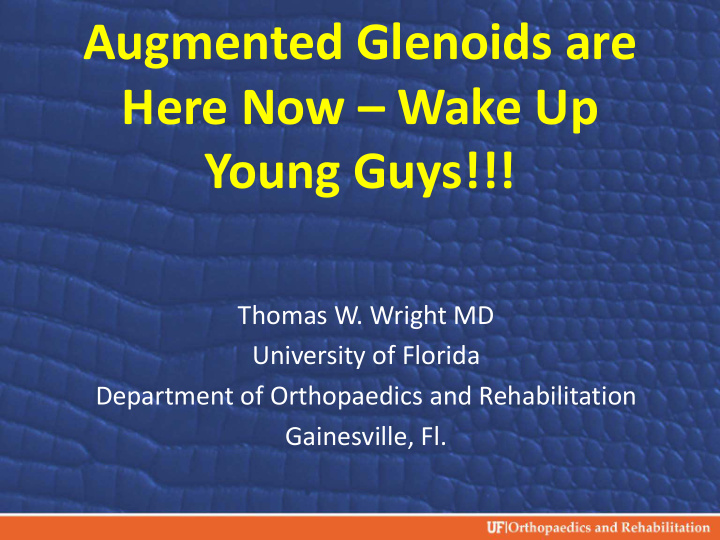



Augmented Glenoids are Here Now – Wake Up Young Guys!!! Thomas W. Wright MD University of Florida Department of Orthopaedics and Rehabilitation Gainesville, Fl.
Disclosure • Design surgeon - Exactech • Institutional Research support - Exactech
The Problem – B2 Glenoid! • TSA - Posterior worn B2 glenoid – Worse functional results – Increased rate glenoid loosening – Increased failure rate – Many now recommend giving up TSA - for RTSA
Posterior Glenoid Wear • Technically difficult to treat - glenoid faces away from surgeon – deltopectoral approach • Worse clinical results
Posterior Glenoid Wear
Treatment Options • Eccentric reaming • Bone grafting • Leaving glenoid retroverted • Augmented glenoids • RTSA
Eccentric Reaming
How much can I correct it? Literature conclusion for posterior wear: Farron article = 10° limit • Gillespie article = 10° limit • Clavet article = 15° limit • Nowak article = 12°to 18° limit • Avg Consensus: ~12° posterior wear limit correct by eccentric reaming -Worn > 12° then different method/solution required
What happens if I don’t correct it? Posterior wear humeral head translates posteriorly • Increased contact pressure – Increased stresses in bone and cement – Increased implant micromotion – And potentially aseptic glenoid loosening… –
Can we do Better? • Posterior augmented glenoid – Decrease reaming saving valuable bone – Eliminate need bone graft – Rebalance joint • Direct forces down glenoid neck • Change shear forces to compressive forces
Posterior Augmented Glenoid • Wedge – Equinoxe Exactech • 8 and 16 degree augmentation – Correction on non articular side • Pegs directed down axis glenoid • Joint is rebalanced • Step – Depuy • Half Wedge – Tornier/Wright
Posterior Augment Glenoid • Posterior Augmented design – full wedge • Minimize removal of anterior cortical bone – removing ridge only
Posterior Augmented Wedge - Composite
Bone Conservation -Due to central peg being off-axis from the backside curvature, the reaming axis and the peg axis are different. -Off-axis cannulated reaming conserves bone by removing less than would occur ordinarily during eccentric reaming to correct for the defect. Glenoid Defect Off Axis Reaming w/ Augmented Implant Eccentric Reaming
The Question? • Full wedge posterior • TSA non- augmented glenoid - augmented concentric non OA B2 glenoids boney deficient VS glenoids
Posterior Augment Glenoid Demographics • > 100 shoulders to date performed at University of Florida – First prototype - 2010
Posterior Augment 2 Yr min F/U – Consortium Data Base • 47 patients – Posterior Augmented Glenoid (PAG) – 31 male shoulders – 16 female shoulders • Age – 66 • 47 control shoulders – Non augmented glenoids (NAG) – Age, Diagnosis, Sex, and f/u matched – NAG – standard all poly glenoid
Comparison of Average and Post-op, Posterior Augmented Peg vs UHMWPE Peg aTSA Patients Internal Active Active Rotation Active Forward External SST UCLA ASES Constant SPADI Score Abduction Flexion Rotation Post 11.3 ± 32.3 ± 92.5 ± 76.7 ± 8.9 ± 138.9 ± 144.4 ± 5.4 ± 54.7 ± Aug Avg 1.2 2.7 10.2 8.7 13.4 27.1 18.8 1.4 21.1 ± St Dev Poly Peg 10.8 ± 31.6 ± 87.5 ± 75.8 ± 13.1 ± 135.4 ± 152.7 ± 5.5 ± 48.6 ± Avg ± St 2.3 4.6 18.1 13.6 19.7 28.3 27.7 1.2 16.3 Dev 0.1836 0.4312 0.1836 0.7394 0.2354 0.5492 0.1049 0.9855 0.1313 P value
Radiographic Lucent Lines • PAG – – Lucent line – 59% – Lucent line score (Lazarus) – 1.1 • NAG – – Lucent line – 38% – Lucent line Score – 0.74
Radiographic Lines • Composite/cage glenoids have 1/3 lucent line incidence as all poly – Now using mostly composite/cage posterior augmented glenoids – Too early to say if PAG lucent line issue will be solved
Shoulder Arthroplasty Subluxation Index (SASI) • PAG Grashey – – 38 centered – 2 superior subluxated – 7 AWOL • PAG Axillary – – 37 centered – 3 anterior subluxated
Complications • 2 – loose glenoids – – Patient 1 happy – head centered in both planes – AEL 125 – AER 35 – Constant 72 – SPADI 11 – Patient 2 MVA - revised • Stay tuned not sure we know the final story
Conclusion Short Term Results • 1 reoperations to date – short term f/u • Improved ROM • Improved Functional Outcomes • No repeat posterior subluxation of humeral head to date
Conclusion – Posterior Augmented • Posterior Augmented Glenoid – Balances joint short term – Saves bone – Makes procedure easier
Recommend
More recommend